Martha’s Vineyard awoke on Friday morning to witness such a scene of destruction and wreckage as the Island never saw before. This is the literal truth, since never before has the Island owned so much property along the shores and waterfronts, susceptible to damage by sea and tide.
War, horrible as it is represented, could hardly have thought about more complete ruin than was to be seen its certain localities and it is quite possible that the extent of the damage may not be definitely known for months. It is believed that only two deaths were caused by the storm. The seventy-foot dragger Marie and Eleanor of Bridgeport, Conn., sailing out of New Bedford, came ashore on the beach at Quenames, and is probably a total loss. Three members of her crew won to safety and were cared for by the Coast Guard, but the skipper, Capt. Axel Neilson of Fairhaven, and one of his men Olaf Haynes of New Bedford, were washed overboard and it is presumed that they were drowned.
The freakish storm struck heavily in some areas, sparing others almost completely, and it is difficult to begin the list of damage as noted in the first survey.
In Vineyard Haven, much damage was done in the West Chop district, where the sea wall was broken and the banks washed away, endangering some of the larger houses. Some of the smaller buildings, dwellings and garages, were completely destroyed, being torn to splinters and scattered far along the up-land where the tide had flowed. Tree limbs went through the roofs of houses, and shattered windows and chimneys were toppled, as in other places. Buildings along the waterfront were flooded, and much merchandise and many tools were ruined.
Probably the greatest single piece of damage was the literal destruction of the Martha’s Vineyard Shipbuilding Company’s shops and yard. While the barge yard, somewhat removed, suffered but slightly from flee inundation, which resulted chiefly in piling up lumber and materials in tangled heaps, and washing tools and equipment about, the other plant now represents a loss that will run into many thousands of dollars. There were boats stored in the buildings, some new ones under construction, hundreds, probably thousands of dollars worth of tools belonging to the yard and to the workmen and quantities of new material. While there is much that can be salvaged, as it would appear, the loss is huge, and the buildings which were not entirely destroyed were gutted by the raging water. These include the office of the plant, the storeroom and all other departments save the private office located on the second floor of one of the buildings.
Freakishness was displayed by the storm in this situation, wherein a large catboat was torn from her moorings in the pond, lifted completely across the road and placed on the lawn at the Cape and Vineyard powerhouse without apparent damage. Another large sport fisherman was left blocking the same highway, just east of the same building. The power station itself suffered no damage, according to reports from the office, but connections with cables and services throughout the Island were so badly damaged that for a time no account of the damage could be made.
Moving from this point toward Oak Bluffs, a landmark of generations was completely obliterated; the bridge house, once used by the bridgetender. From this point, the damage was in Oak Bluffs, and it would be difficult to say which town suffered greatest, this town or Edgartown. Huge sections of Beach Road in this township were undermined and broken. This damage extends along East Chop drive, where houses were torn apart, others reduced to splinters, garages and other small building ruined, and the drive itself buried deeply in sand and wreckage, until it was impassable over the Highlands.
Some damage was apparent around Oak Bluffs harbor, but the fleet of fishing boast which sough shelter there seemed to have ridden out the storm better than craft in other places. Wind and tide worked its worst along certain sections of the waterfront, and the camp ground was a mass of tangled trees and shattered dwellings. Yet the Vineyard Laundry, scarcely inches above normal tide limits, suffered no damage whatever.
Farther into the village, many buildings were badly damaged, the seawall to the east, on the drive was undermined and huge sections of the broad concrete walk fell down the bank. The town bath houses and pier were completely swept away, leaving only the office, and Cluster Village, so-called, suffered sever damage to many houses, which were literally torn apart.
From this point, Beach Road was practically impassible for miles, being buried in sand, and probably damaged beneath this covering as well. Harthaven bridge appeared to be intact, but the approaches of Sengekontacket bridge were undermined and damaged.
Inland, there was still a trail of scattered piles of splinters gathered by wind and water.
In the up-Island towns little detail could be learned on Friday, the roads being impassable, and only occasional individuals who drove through fields and across private property, being able to make the trip down-Island. There persons reported that not a house or camp was left standing on South Beach, from the West Tisbury line to the Gay Head line. It was also reported that Hariph’s Creek bridge, destroyed in the hurricane six years ago, had again been washed out.
At Menemsha Creek, the report stated that many boats were damaged, but few seriously. One at least was reckoned a total loss, and possibly others, while several buildings along the waterfront were torn from their foundations and shattered against the breakwater and jetties. The causeway leading to the buildings on the neck between the creek and basin was partially washed away as in the last hurricane, but all in all it was the opinion that the creek suffered far less than it did six years ago.
Summing up the Island scene, it is but reasonable to suggest that the Island has much to be thankful for, in the light of damage known to have been done elsewhere. But it is without doubt the most crushing blow that the Island has ever received as the result of storm. The loss cannot be calculated. Thousands of dollars will be required to repair damage which must take place as soon as possible, such as highways and streets, guard rails, the clearing of roads and streets of trees, and the necessary repairs to occupied houses. Thousands more will be required to repair and float boats and vessels which cannot be left where they were stranded, and which are needed by their owners.
Too much credit cannot be given the men who stood watch during the storm and who turned out to help clear away the wreckage after it was over. State Police and Coast Guard patrolled all outlying districts for hours before dark on Thursday, causing all people to leave points where danger threatened. By this means, a serious loss of life was averted. During the evening, one of the officers remained on patrol, eventually being cut off from returning from up-Island and without communication with the barracks, save his radio. The other, remaining on watch at the station, was still handling radio messages on the following afternoon, having had neither sleep nor food.
Local police remained on duty, assisted by state guardsmen in Tisbury and Oak Bluffs. In the latter town, these guardsmen were still on duty on Friday, have spent a night of anxiety and toil, rescuing people from danger, patrolling areas where danger threatened, and otherwise striving to safeguard the public and property insofar as was possible. The job done by the combined efforts of police and guardsmen was not less complete in Vineyard Haven, on Thursday night.
For the rest, the Island view following the storm was a nightmare of confusion and wreckage. The spoilage of beauty spots was extensive. Great shade trees lay prostrate in windows, the roadside groves, splintered, twisted and wrenched apart, great gullies were washed by waves and tides in formerly terraced embankments, and shattered wreckage lay everywhere in heaps and windows, or tangled masses mixed with leaves and seaweed.
In the midst of this scene of storm and danger, neither the operations of life nor death were to be interrupted, for as fishermen were drowning on South Beach, a son was born to Mr. and Mrs. Kenneth Hearn, of Vineyard Haven, at the Martha’s Vineyard Hospital, and all functions of that institution were disrupted to a degree by the storm which swept the sea to within a few yards of its door, yet the staff carried on.
The hospital has storage batteries to provide emergency lights in the operating room, but other essential activities went on by lantern lights.
The problem which seemed to face the Island in the smiling sunshine of Friday afternoon was to find the necessary help to clear away the wreckage, make the needed repairs and reestablish Island institutions. All available men went to work, wielding the axe or oar, but the task seemed endless and the need great indeed. Perhaps no more sincere prayer ever was lifted from Vineyard hearts as this, follwong the storm: “Deliver us from evil,” especially such evil as this.

Hurricane Fund Launched
Before noon on Friday, while the Gazette staff was out collecting as much of the record of the hurricane as possible, a check for $100 was slipped under the office door. Thus was born in the Vineyard’s second hurricane relief fund, the successor to the Martha’s Vineyard Fishermen’s Fund of 1938, which did so much to rehabilitate the fishing industry almost prostrated by the storm of that year.
All who wish to contribute to the Hurricane Fund may do so at the Martha’s Vineyard Nation Bank, the Edgartown National Bank, or the Vineyard Gazette. All contributions will be acknowledged in the Gazette.
It was inevitable that lovers of the Vineyard should want to do something to help in the present catastrophe - for catastrophe it is. What so much of NEw England suffered from wind in the 1938 hurricane, the Vineyard has suffered now.
Those who saw the Island all green and beautiful during the past weeks must weep in their hearts to see it now. The loss to individuals is beyond ascertaining or stating at this moment. So moving is the scene however, that following that first $100 check, spontaneous gifts have come in already to a total of $305, on the wish of individuals to do something to help, perhaps, as the first note under the Gazette door said, to contribute for those not so fortunate, something of what one might so easily have had to pay if the change of the storm had been a little different.

Gazette is On the Move
Most of this issue of the Gazette was ready Thursday evening for the regular press run Friday Morning, awaiting only last minute news. Not a gear has turned in the Gazette office since.
Through the cooperation of Capt. Robert L. Jackson Jr., communication was established with New Bedford. Through the genuine helpfulness and cooperation of Melcolm West, the steamboat company’s agent at Vineyard Haven, the forms were taken to New Bedford Saturday night.
With characteristic friendliness, George H. Reynolds put his typesetting machines and other facilities at the service of the Gazette staff, and work was carried on at the Reynolds plant from the arrival of the first boat at noon Saturday until after 11 Saturday night, and again Sunday.
Where the paper will have been printed when readers see these lines cannot now be said. As this is put into type in New Bedford, there is still no telling where the press will be found, but Plymouth seems likely, if the power there comes on in time. There is no feasible press in New Bedford and the staff is on the move.
WIND BLEW 85-100 M.P.H.
Albert N. Hudson of Edgartown, basing his estimate on long experience at sea and in other hurricanes, said that he would estimate the wind Thursday night as around eighty-five miles an hour at Edgartown. He said it was one of the worst blows he had ever experienced. His estimate checked closely with the record at the air station until the instrument broke.
Word from Quonset was that the wind velocity was recorded at 85 miles an hour straight, with gusts exceeding 100. This also checks with the judgement of Mr. Hudson.

WHITING TREES GO DOWN
Among the worst losses of the big storm from a sentimental and historic standpoint, certainly from that of scenic beauty and by no means least in terms of money, was the destruction of many significant trees at the Johnson Whiting place in West Tisbury. This lovely spot, one of the most famous and best-loved on the Vineyard, was devastated, tree after tree going down.
The house itself just missed damage from the crashing trees, so many of them mighty and ancient, and all still strong enough for any test except that of a tropical hurricane. The only real structural damage, was the tearing off of the front porch.
In addition to so many trees and the general farm damage, the Whitings also lost their South Beach camps, a very serious loss indeed.

CORNELL PLACE FLOODED
High tides flooded the home of Katherine Cornell on the Vineyard Sound shore near Tashmoo, and Miss I.A.R. Wylie, who had been occupying the house during Miss Cornell’s absence, moved inland with her guests. On Friday evening Miss Wylie, her two guests, and four dogs, including Miss Cornell’s dachshunds, Miss Wylie’s bulldog George, and a newly acquired companion, were installed in an apartment at Edgartown.
Miss Cornell’s summer home also suffered from the flood of 1938.

Tabernacle Cross Down
The house on Atlantic avenue, Oak Bluffs, owned by Mrs. Howard P. Wall, was almost destroyed. The cross on the tabernacle was blown down.

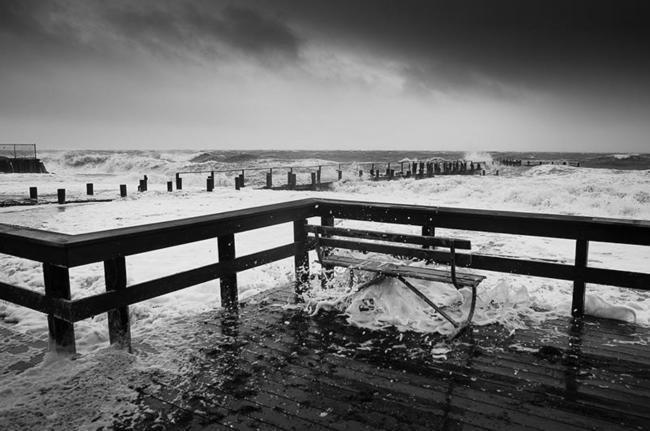




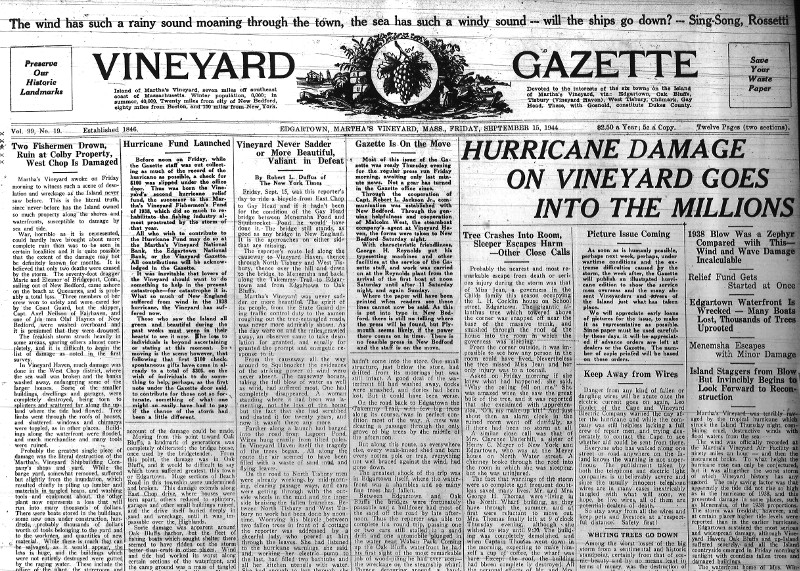
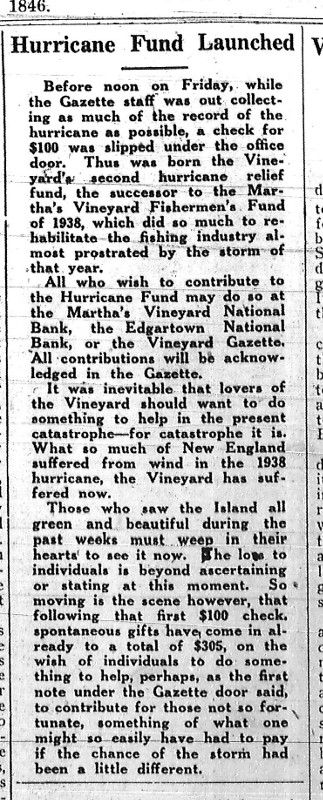
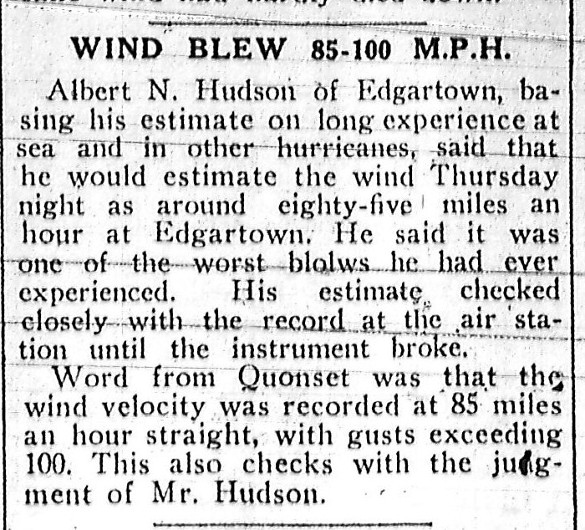


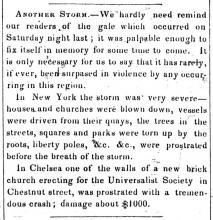
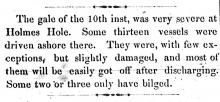

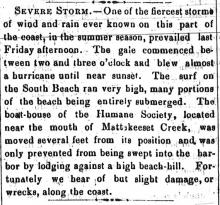
Comments